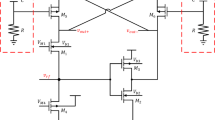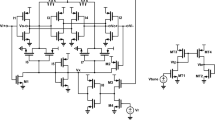Abstract
In modern transreceivers, analog base band section is very crucial which deals with channel selectivity, antialiasing and dynamic range. Nowadays OTA become a basic building block of any analog system.For better performance of RF front end a filter which is used in base band section must include many characteristics like high linearity, tunable BW, low noise etc. A second order low pass Gm-C Filter is implemented.The core of this filter is power efficient OTA. The OTA is implemented to operate at a ±1.0 V supply voltage with a power consumption of 0.42 mW. All simulations has been performed using Tanner EDA tool using CMOS technology with parameters TSMC 0.18 µm. The simulation results of this circuit show that it has a high DC gain of 76 dB and a transconductance of 360 µS.
Access provided by Autonomous University of Puebla. Download conference paper PDF
Similar content being viewed by others
Keywords
1 Introduction
Rapidly growing, mobile and wireless communication market is highly dependant on the receiver architecture for analog baseband signal processing, there fore high frequency and low power, fully integrated filters received considerable worldwide attention. In today’s Scenerio multi-standard transceivers are so much in demand and direct conversion architectures are best suited forthat purpose [1]. The RF front end module of the receiver includes a variable gain amplifier and a LPF. The range of variable gain for UWB analog front ends should be small. Therefore, the realization of voltage gain amplifier is not important. Therefore, the low-pass filter design has become the most crucial design in the analog front end [2, 3]. Analog filter based on operational transconductance amplifier (OTA) Capacitor (so-called OTA-C or gm-C) filters have attracted the attention in recent research. In comparison of traditional active RC filter, OTA-C filter has better performance. OTA-C filters offer simple in design, high-frequency capability, Electronic adjustability, suitable for monolithic integration, reducing the number of components and the potential of design automation. The low-pass filter based on Gm-C is the only choice when the cutoff frequency of the filter reaches in the range of GHz [4,5,6,7,8,9,10]. OTA-C filters also have great limitations. Good linearity of filters needed a highly linearized OTA. The increase in the linear range will inevitably reduce the usable range of transconductance of the OTA at a given power supply voltage, and increase the OTA noise. At present, great importance is attached to the implementation of integrated filters using sub-micron CMOS technology. CMOS technology provides favorable features for high-density integration, such as low power consumption, Power supply voltage and low static power consumption of digital circuits.
2 Basics of Filters
The function of an ideal low-pass filter is that, it will pass the signals below the cut off and eliminate the signals above the cut off frequency. When any filter is designed for a particular application various trade-offs should be considered between the parameters. So many types of filters provide the trade off between attenuation and phase response which will depend on the application. Butterworth filters provides the good trade off between attenuation and phase response. Some times butterworthe filter is known as maximally flat filter [11].
The realization of a second-order low-pass Butterworth filter is made with the following transfer function
Butterworth filter has zero ripples in the pass band and stop band. Frequency domain response and time domain response plays a important role while designing a filter for a particular application which further decides the complexity and cost of the filter. In all pole filters category two filters are generally used Butterworth and Bessel [13,14,15]. Butterworth filter gives good amplitude with fair trasient behaviour. Chebyshev filters give smaller transition region in comparison of butterworth. For higher order filters butterworth filter is preferred. In designing higher order filter multiple sections of first/second order filters are used. The characteristics of these sections should be aligned for good response of a higher order filter.
2.1 Basics of Operational Transconductance Amplifier
Due to the feature of tunability of transconductance with bias current operational transconductance amplifier become very useful in the realization of active filters. OTA provides linear electronic adjustability. OTA circuits consume less power and can be operated at lower voltage. At present high frequency, high linearity, and low power are the important parameters of CMOS OTAs [16]. Filters designed using OTA do not need resistors that are why they are easier to fabricate. Filter performance directly depends on the characteristics of the OTA (Figs. 1 and 2).
OTA:
Balanced OTA:
3 Results and Discussion
3.1 Conventional OTA
With three high performance current mirrors and using a differential pair (M1, M2) the conventional OTA is achieved. This OTA is working on low operating voltage. By using a super cascode transistor high slew rate, a large bandwidth and a high open loop gain have been achieved [17]. Both the transistors M1 and M2 are working in the saturated region.
So, the differential input voltage is as follows
Expressions of current Iout is as follows
Where \({\upbeta }_{{\text{n}}} = {\upmu }_{{\text{n}}} {\text{C}}_{{{\text{ox}}}} \left( {\frac{{\text{W}}}{{\text{L}}}} \right)_{{1,2}}\) and Iss is the bias current and Gm is given by
Proposed OTA
By using stage attenuation technique linearity can be better than the conventional OTA (Fig. 3). MOS transistor pair (M1a, M2a) forms attenuator and (M3, M4) transistors of the PMOS type will act as load [18, 19]. Both M1a and M2a are operated in the saturated region. So the differential input voltage is defined by
Output current is as follows
The differential gate voltage of the load transistors is given below:
Where m = attenuation factor
Transconductance is given by
The simulation results of the proposed CMOS OTA and Conventional OTA has been done by using Tanner EDA tool using TSMC 180 nm technology (Fig. 4 and Table 1). This circuit is working with ±1.0 V supply voltage with a dc voltage VB1 = 0.1 V and the value of capacitive load is 10 pF. The DC transfer characteristic of the proposed OTA is shown in Fig. 5, the OTA (proposed) provides good linearity in the range [−0.6 V, 0.6 V].
The trascondcutance Gm of the OTA proposed is plotted and it can be seen that it is more stable in the interval of [−0.6 V, 0.6 V] and the maximum value of gm is seen to be equal to 360 μS (Fig. 6) (Table 2).
The frequency response of the conventional and proposed OTA is shown in Fig. 7. The open loop gain of proposed OTA 76 dB. For OTA conventional, a less gain of 44 dB is acheived. In Table 3, the performance parameters of both OTA (conventional and proposed) along with some of the works are compared (Table 4).
4 Application
4.1 Theoretical Analysis
Range of transconductance can be increased for the filter applications. For analog base band circuit low pass filter plays important role.
On putting value of V− from Eq. (16) into Eq. (15)
On applying KVL
Equating (17), (18) and then solving
Comparing with standard transfer function, It is Low Pass Filter.
Second order butterworth low pass filter is shown in Fig. 8. Transfer fuction of this filter is given in Eq. (29).This circuit is designed using two proposed OTA.
Simulation Results
The proposed filter operates at a low supply voltage of ±1.0 V. Power consumption of this filter is 0.8 mW (Table 5 and Fig. 9).
5 Conclusion
In this first a low voltage and low power OTA was implemented using CMOS technology using TSMC 0.18 nm parameters. Which improves the linearity of operational transconductance amplifier. In this OTA signal attenuation technique is used. This topology acheives a good differential input range ±0.6 V with a gain of 76 dB. Based on this circuit, a second order voltage mode low pass filter has been implemented and a power consumption 0.7 mW has been obtained.
References
Zhou, M., Wang, K.: 0.18 mW/pole inverter-based Gm C bandpass filter with automatic frequency tuning. Electron. Lett. 54(15), 943–945 (2018)
Rezaei, F., Azhari, S.J.: A new controllable adaptive biasing linearization technique for a CMOS OTA and its application to tunable Gm-C filter design. Microelectron. J. 46, 810–818 (2015)
Sarrafifinazhad, A., Kara, I., Baskaya, F.: Design of a digitally tunable 5th order GM-C filter using linearized OTA in 90 nm CMOS technology. In: IEEE International Symposium on Signals, Circuits and Systems (ISSCS) (2015)
Acosta, L., Jiménez, M., Carvajal, R.G., Lopez-Martin, A.J., Ramírez-Angulo, J.: Highly linear tunable CMOS Gm-C lowpass filter. IEEE Trans. Circ. Syst. I Reg. Pap. 56(10), 2145–2158 (2009)
Lo, T.-Y., Hung, C.-C., Ismail, M.: A wide tuning range Gm-C filter for multi-mode CMOS direct conversion wireless receivers. IEEE J. Solid-State Circ. 44(9), 2515–2524 (2009)
Crombez, P., Craninckx, J., Wambacq, P., Steyaert, M.: A 100-kHz to 20-MHz reconfigurable power linearity optimized GM-C biquad in 0.13-μm CMOS. IEEE Trans. Circ. Syst. II Exp. Briefs 55(3), 224–228 (2008)
Glib, J.P.K.: Bluetooth radio architectures. In: IEEE Radio Frequency Integrated Circuit Symposium, Digest of Papers, 11–13 June 2000, pp. 3–6. IEEE (2000)
Elwan, H.O., Younus, M.I., Al-Zaher, H.A., Ismail, M.: A buffer-based baseband analog front end for CMOS Bluetooth receivers. IEEE Trans. Circ. Syst.-II Analog Digit. Process. 49(8), 545–554 (2002)
Johns, D., Martin, K.: Analog Integrated Circuit Design, 1st edn. Wiley, New York (1997)
Razavi, B.: RF Microelectronics, 1st edn. Prentice Hall, New York (1998)
Ishikuro, H., et al.: A single-chip CMOS Bluetooth transceiver with 1.5 MHz IF and direct modulation transmitter. In: 2003 IEEE International Solid-State Circuits Conference, Digest of Technical Papers, ISSCC, vol. 1, pp. 94–480 (2003)
Andreani, P., Mattisson, S.: On the use of Nauta’s transconductor in low-frequency CMOS Gm-C bandpass filters. IEEE J. Solid-State Circ. 37(2), 114–124 (2002)
Leung, W.Y., Cheng, K.M., Wu, K.-L.: Design and implementation of LTCC filters with enhanced stop-band characteristics for Bluetooth applications. In: 2001 Asia-Pacific Microwave Conference, APMC 2001, 3–6 December 2001, vol. 3, pp. 1008–1011 (2001)
Son, M.H., Lee, S.S., Kim, Y.J.: Low-cost realization of ISM bandpass filters using integrated stripline structures. In: IEEE Radio and Wireless Conference, RAWCON 2000, 10–13 September 2000, pp. 261–264 (2000)
Liu, H., Zhu, X., Lu, M., Sun, Y., Yeo, K.S.: Design of reconfigurable dB-linear variable-gain amplifier and switchable-order GM-C filter in 65-nm CMOS technology. IEEE Trans. Microwave Theory Tech. 67(12), 5148–5158 (2019). https://doi.org/10.1109/TMTT.2019.2947668
Abdolmaleki, M., Dousti, M., Tavakoli, M.B.: Design and simulation of tunable low-pass Gm-C filter with 1 GHz cutoff frequency based on CMOS inventers for high speed telecommunication applications. Analog Integr. Circ. Sig. Process. 100(2), 279–286 (2019). https://doi.org/10.1007/s10470-019-01484-0
Taleja, M.K., Kumar, M.: Bias current effect on gain of a CMOS. In: IEEE International Conference on Advanced Computing & Communication Technologies, pp. 396–397 (2011)
Das,S.S., et al.: An analytical 2-D model of triple metal double gate graded channel junctionless MOSFET with hetero-dielectric gate oxide stack. Solid State Commun. 340, 114521 (2021). ISSN: 0038-1098. https://doi.org/10.1016/j.ssc.2021.114521
Kar, S., Sen, S.: A highly linear CMOS transconductance amplifier in 180 nm process technology. Analog Integr. Circ. Sig. Process. 72, 163–171 (2012). https://doi.org/10.1007/s10470-011-9796-1
Abbasalizadeh, S., Sheikhaei, S., Forouzandeh, B.: A 0.9 V supply OTA in 0.18 nm CMOS technology and its application in realizing a tunable low-pass Gm-C filter for wireless sensor networks. Sci. Res. Circ. Syst. 4, 34–43 (2013)
Acknowledgements
This work is an intellectual property of Integral University vides the Manuscript Communication no. IU/R & D/2021-MCN0001257. We would like to acknowledge the Integral University, Lucknow, India for providing an opportunity to carry out this research work.
Author information
Authors and Affiliations
Corresponding author
Editor information
Editors and Affiliations
Rights and permissions
Copyright information
© 2022 The Author(s), under exclusive license to Springer Nature Singapore Pte Ltd.
About this paper
Cite this paper
Mittal, N., Khan, I.U., Charan, P. (2022). Design of Power-Efficient Operational Transconductance Amplifier in the Application of Low Pass Filter Using 180 nm CMOS Technology. In: Mekhilef, S., Shaw, R.N., Siano, P. (eds) Innovations in Electrical and Electronic Engineering. ICEEE 2022. Lecture Notes in Electrical Engineering, vol 893. Springer, Singapore. https://doi.org/10.1007/978-981-19-1742-4_11
Download citation
DOI: https://doi.org/10.1007/978-981-19-1742-4_11
Published:
Publisher Name: Springer, Singapore
Print ISBN: 978-981-19-1741-7
Online ISBN: 978-981-19-1742-4
eBook Packages: EnergyEnergy (R0)













